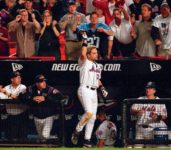Business as Usual for the Mets on the Piazza 9/11 Jersey

Thanks to three people, Anthony Scaramucci, Tony Lauto, and another in identified buyer (Oliver Stone?), Mike Piazza‘s 9/11 jersey is safe. The trio agreed that the jersey will forever rotate between Citi Field, the 9/11 Museum, and the Baseball Hall of Fame. These three people stepped up and did what was right and what was needed.
They had to step up because Mets ownership wouldn’t. As Kevin Kernan of the New York Post reported, the Mets never made a bid for the jersey.
To be fair, let’s not revisit the past here. We don’t know why the jersey was sold. It might’ve been the result of the financial troubles the Wilpons experienced as part of the Madoff scandal. It could’ve been an oversight. It’s possible no one realized the importance of the jersey. Maybe, just maybe, it was never supposed to be sold in the first place, but it was due to oversight. Fact is we’ll never know why it was sold. Most agree that in retrospect, it was wrong to sell the jersey. The Mets organization admitted as much in their statement to the New York Post stating, “We made a mistake in selling the jersey and Jeff [Wilpon] called Mike [Piazza] to express our regret in doing so.”
With the jersey up for sale, the Mets got that rare opportunity to right a wrong. They chose not to do so. They didn’t despite Jeff Wilpon assuring Piazza the Mets contacted the seller and were “making a concerted effort to get the jersey back.” They didn’t. Instead, they let someone else step in and purchase it.
At this point, it’s inexcusable. They told their newly elected Hall of Famer, they were going to make a concerted effort, and they didn’t. They got lucky because three people not only purchased it, but also agreed it should be on permanent display instead of in one of their homes. The thing is as the owners of that jersey that was their right. That was what the Mets risked.
At this point, we just have to ask,”Why?”
Why didn’t the Mets realize the jersey’s importance in the first place? Why didn’t they make an effort to buy the jersey? Why did they not keep their promise to Piazza? Why didn’t they understand what the jersey meant to the fans? Why were they willing to let the jersey to possibly be sold to someone who didn’t feel the obligation to display the jersey publicly?
The answer to all of these questions, and many more is, at the end of the day, baseball is a business. The owners only care about the fans to the extent that they want to create an environment suitable enough for them to spend as much of their disposable income on the team as possible. To Mets ownership, the Piazza 9/11 jersey didn’t have any special meaning. Rather, it was a jersey: (1) that could be sold for a profit; and (2) whose current purchase price was cost prohibitive. Pure and simple, these were business decisions.
The Mets will continue to make business decisions like they’ve always done. They’ll sell bricks which line the outside of Citi Field, but they won’t erect a Tom Seaver statue. They won’t sign a player like Yoenis Cespedes, despite the fans’ attachment to him, unless it is at a price suitable to them. For better or worse, that’s how the Mets operate.
And that’s all the Piazza 9/11 jersey decisions were to them – business decisions.